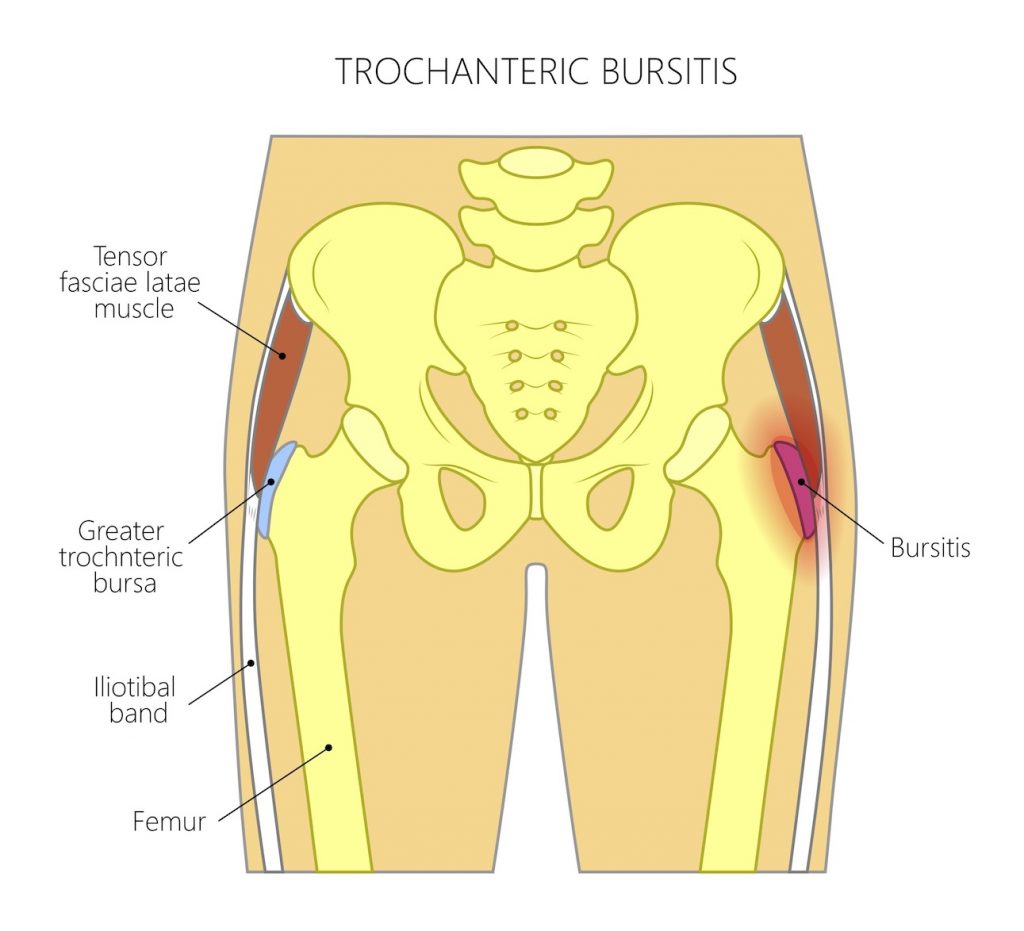What is hip bursitis?
Bursae, are small, jelly-like sacs that are located throughout the body, including around the shoulder, elbow, hip, knee, and heel. They contain a small amount of fluid, and are positioned between bones and soft tissues, acting as cushions to help reduce friction. Bursitis is term used to describe the inflammation of the bursa. Dr. Austin Chen, orthopedic hip specialist has extensive training in bursitis of the hip.
There are several major bursae in the hip that typically become irritated and inflamed. One bursa covers the bony point of the outer hip bone called the greater trochanter. When this bursa becomes inflamed it is called trochanteric bursitis. The other bursa is called the iliopsoas bursa. It is located on the inside (groin side) of the hip. When this bursa becomes inflamed, it is often referred to as hip bursitis. This condition is not as common as trochanteric bursitis, but is treated in a similar manner.

What are the symptoms of bursitis of the hip?
Trochanteric bursitis causes pain on the outer and lateral portion of the hip, and may be confirmed by pain-numbing injection administered by Dr. Chen.
Iliopsoas bursitis typically causes pain in the front of the hip around the groin. The pain can also radiate down into the thigh area. In the early stages, the pain is usually described as sharp and intense. Later, the pain may become more of an ache and spread across a larger area of the hip.
Typically, trochanteric bursitis pain is worse at night, when lying on the affected hip, and when getting up from a chair after being seated for a while. It also may get worse with prolonged walking, stair climbing, or squatting. Trochanteric bursitis may closely mimic gluteal tendinitis or even gluteus medius/minimus tear. Also known as the “rotator cuff of the hip,” gluteus medius tears are often associated with weakness. If the bursitis persists despite conservative measures, an MRI may be warranted to assess for a gluteus medius tendon damage.
What are the risk factors for bursitis of the hip?
Hip bursitis can affect anyone, but is more common in women and middle-aged or elderly people. It is less common in younger people and in men.The following risk factors have been associated with the development of hip bursitis:
- Repetitive stress (overuse) injury. This can occur when running, stair climbing, bicycling, or standing for long periods of time.
- Hip injury. An injury to the point of your hip can occur when you fall onto your hip, bump your hip, or lie on one side of your body for an extended period of time.
- Spine disease. This includes scoliosis, arthritis of the lumbar (lower) spine, and other spine problems.
- Leg-length inequality. When one leg is significantly shorter than the other, it affects the way you walk, and can lead to irritation of a hip bursa.
- Rheumatoid arthritis. This makes the bursa more likely to become inflamed.
- Previous surgery. Surgery around the hip or prosthetic implants in the hip can irritate the bursa and cause bursitis.
- Bone spurs or calcium deposits. These can develop within the tendons that attach muscles to the trochanter. They can irritate the bursa and cause inflammation.
What are the treatment options for bursitis of the hip?
Treatment of bursitis may include anti-inflammatories, physical therapy and stretching, or cortisone or platelet rich plasma (PRP) injections. If bursitis does not resolve with these measures, arthroscopic surgery may be used to debride the inflamed, painful bursa.
